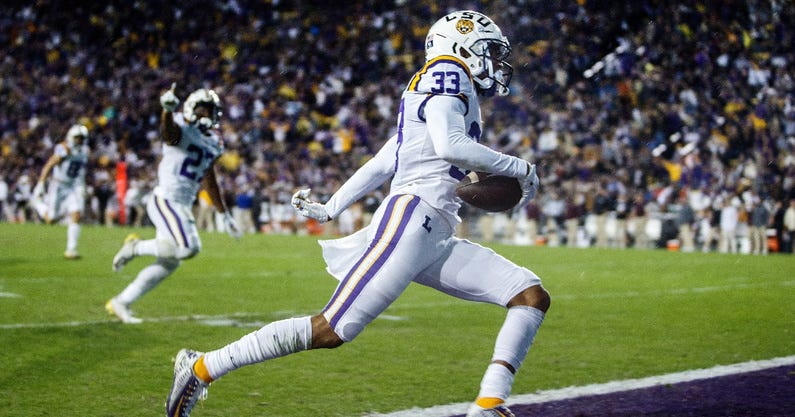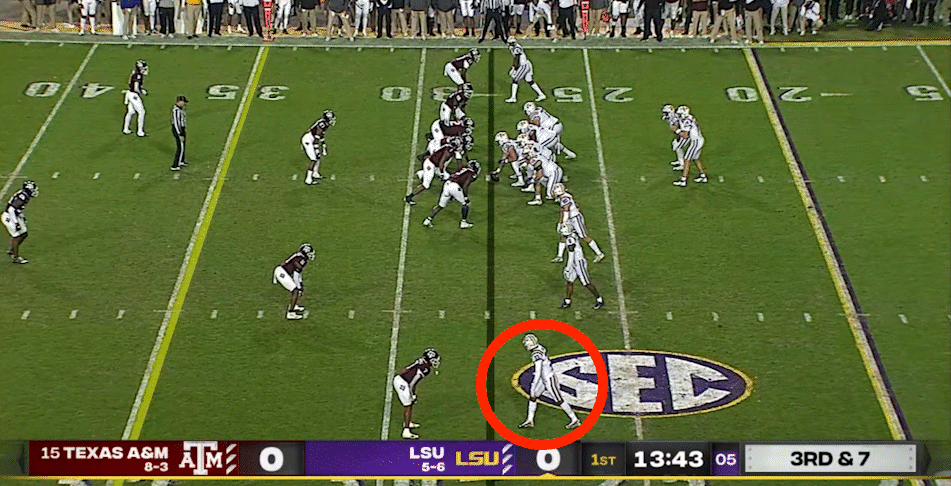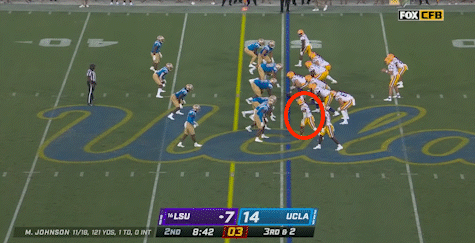MEET A TRANSFER: Trey Palmer
An extremely talented receiver who hasn't *quite* reached his potential
Nebraska made liberal use of the transfer portal this offseason, adding 13 total new players from four-year schools, seven of whom are likely starters. This is the second in a series of posts breaking down of some of the most prominent new names you’ll see on Saturdays, examining their strengths and areas of improvement and what sort of impact Husker fans can expect. Here’s a link to the previous entry on Ochaun Mathis.
Nebraska’s offensive tackles were atrocious in pass protection last year. That was obvious from the eye test and backed up by the numbers: Left tackle Turner Corcoran and right tackle Bryce Benhart allowed a combined 54 pressures on the season (Nebraska’s three other starting linemen allowed a combined 17), and Corcoran finished the season with a 0.0 pass blocking grade from PFF.
Why am I talking about the offensive tackles in a post about a wide receiver? Because a good receiver may be the best shot at keeping them from derailing Nebraska’s season.
Short of finding new players at the position — good tackles rarely hit the transfer portal, and you’re not recruiting elite, Day One starter types unless you’re one of like, five teams — the best way to improve your tackle play is to give them help or get better around them. You can get a quarterback who processes and gets the ball out of his hands fast. You can bring in a new offensive coordinator to turn the offensive dials to incorporate more quick passing over play-action shots. You can get a new offensive line coach who hopefully can hone technique to make former highly ranked recruits not look like they’re moving in quicksand all the time.
You can also get a wide receiver fast and talented enough to win quickly so that the tackles don’t have to hold up in protection as long. LSU transfer Trey Palmer ***MIGHT*** be that guy. The former star recruit never quite caught on with the Tigers, but he has the game-changing talent to dramatically reshape an offense if he’s ever able to tap into that skill. To look at whether Palmer — whom I deeply rock with for wearing the #33 AS A RECEIVER — might be able to produce more as a Husker, I checked out three games from last year, his first with any real playing time: the season-opener against UCLA, a mid-year contest against Arkansas and the Tigers’ regular season finale against Texas A&M.
OVERVIEW
Position: Wide receiver/kick returner
Measurables: 6’1, 190 pounds
Eligibility remaining: One year (plus an additional optional COVID-19 year)
Transfer ranking: 0.89 (No. 156 nationally, No. 28 wide receiver)
High school ranking: 0.94 (four star, No. 112 nationally, No. 18 wide receiver)
Relevant stats: 458 career receiving yards, 3 career receiving touchdowns, 2 career punt and kick return touchdowns
Palmer was a ballyhooed recruit — a five-star and a top-20 national player per Rivals — out of a very small town in Louisiana but never fully put it together for the Tigers. He played sparingly as a reserve receiver and return specialist as a true freshman on the 2019 Joe Burrow-led national title team and got slightly more run as a sophomore. His junior season last year was supposed to be his chance to step into a larger role, but after a promising start — 50 routes run and 10 targets in the Tigers’ season opener — Palmer played just 146 snaps over the next 10 games as he was usurped by younger players. Injuries to others ahead of him got him back in the lineup for LSU’s regular-season finale against Texas A&M, where he turned in his best receiving performance of the year. He finished sixth on the team with 344 receiving yards, as LSU’s offense seemed to struggle with poor design/management and quarterback play for most of the year. Palmer WAS a dangerous kick return option in his time at LSU, scoring a long return touchdown each of his first two seasons. And the most important stat for SPECIAL TEAMS-TRAUMATIZED Husker fans: one career muff on a kick or punt return.
With head coach Ed Orgeron out in Baton Rouge, Palmer decided to follow his wide receivers coach Mickey Joseph to Lincoln this offseason.
As a receiver, LSU seemed more interesting in using him as a gadgety-player — mostly getting him the ball on screens, short curls or shallow routes running across the field — and he led the team in targets behind the line of scrimmage and was second in the short area despite only really playing much in a handful of games. But watching tape, I saw a decent amount of success working down the field that was backed up by the numbers: PFF actually gave him a better receiving grade working 20+ yards down the field (79.1) than it did on passes behind the line of scrimmage (74.1) and in the short (71.2) and intermediate (57.8) areas. I’m not quite sure why he wasn’t given more opportunity to cook on deeper routes at LSU.
In terms of alignment, Palmer played slightly more in the slot (54.1%) than out wide (45.9%) season-long per PFF. It broke down like this in the games I watched (though this might be skewed as he predominantly played out wide in the Texas A&M game to account for injuries:
Based on the spring game it seems like Nebraska wants to primarily use him in the slot, but he does have some inside-outside versatility.
STRENGHTS
Athleticism/Smoothness
When Palmer is in the open field or has the ball in his hands, he GLIDES:

I’m not even sure if his feet are touching the turf here. Palmer displayed elite movement ability and generally got to where he wanted to go faster than his opponent could; when your athleticism stands out at LSU and in the SEC, you know you have some juice. Last year’s transfer slot receiver Samori Toure was also VERY SMOOTH, but based on this LSU tape I’m willing to say Palmer is the best athlete NU has had at the position in a while.
[SIDEBAR] Who was the last fast receiver Nebraska had??? Wan'dale obviously had Nightcrawler-level agility but wasn’t particularly blazing in a straight line. JD Spielman and De'Mornay Pierson-El were like 4.5/4.6 guys. Do we have to go all the way back to … Kenny Bell? We need some SPEED [END SIDEBAR]
Releases (Most of the Time)
Palmer showed great footwork when pressed and was great at using his burst and quick feet to get past corners before they could get their hands on him. Being a freak athlete is a big advantage, but a lot of releases is coaching/technique, and Palmer has obviously been well coached:
The play above happens pretty fast, but A&M appears to be playing a variation of Cover 1 Press out of a pressure look (the corner covering Palmer looks back to the QB like he’s playing zone, but everyone else appears to be in Cover 1?? Could be some sort of match coverage). The outside corners’ responsibilities in Cover 1 are to funnel receivers to the middle of the field to where they have deep safety and robber help. The one thing they can’t do is get beat to the outside at the snap. Palmer displays some sharp footwork here, using an inside stutter step to get the corner to commit inside before Palmer accelerates back to the outside and uses a long-arm to get the angle him.
Overall, his athleticism made it hard for corners to get their hands on him off the ball, but when a defender was able to get their hands on him, things went … less well. Palmer is likely going to play predominantly in the slot for NU, so he shouldn’t see a ton of press coverage, but it’s good to know he has this in his toolbag.
Use of Route Tempo/Feel
On the few actual downfield routes Palmer was allowed to run, he demonstrated an ability to use varying tempos as a weapon against defenders. Below against UCLA he gets man coverage again on a Cover 1 blitz on a long third down. He slow-plays the route like he’s going into the flat as the checkdown before hitting the gas on a cut back inside on an angle route to get open for the first down. His feel on the delay also helps him avoid the Cover 1 robber player (the linebacker who drops to the hash) to give his quarterback a passing lane.
Some of this is route design and coaching, but it does take some savvy/feel to do this well and shows he can use technique as a weapon and that he isn’t all just physical talent. This will be especially useful in a Mark Whipple passing game that relies predominantly on medium-depth routes like Basic ins and Corners that need receivers who can sell a vertical stem before cutting them off.
I also saw him pulling similar tricks on deeper Seam and Wheel routes. But he doesn’t have a ton of reps where he’s not running some sort of screen or curl or short route, so it’s still kind of hard to gauge.
Elusiveness with Ball in Hands
Palmer doesn’t have a ton of physicality to his game or strength overall and certainly isn’t running anyone over, but getting your hands on him is hard as hell.
Keep in mind that play is against a Texas A&M defense that is loaded with future pros and he’s making them look absolutely silly. This will be a change from Toure; I think the two have a lot of similarities in their games and will be used in some similar fashions, but Toure more or less when down when a defender got close to him whereas Palmer is a legit run-after-catch beast.
Willing Blocker for Size
While he’s again not the strongest player, Palmer did show some toughness and willingness to mix it up as a blocker and stick his nose in the run game. He was not super successful all of the time, but it’s good he’s got some dawg in him and is willing to stick his nose in there! That’s all you can really ask for from a 190-pound receiver.
AREAS OF IMPROVEMENT:
Route Running
Palmer is very technically sound in a lot of areas, but his footwork could use some refinement. Mostly he just wastes a ton of steps in his routes:
Focus on his first move at the snap in the clip above. His first motion is lifting his back foot up and placing it back down — then he gets off the ball; that’s a wasted step. He makes up for it because he runs a 4.4, but great receivers are constantly moving forward in their routes as efficiently as possible, and that’s not what Palmer is doing above. That’s a wasted edge he could have against SEC and Big Ten corners.
Above vs. Arkansas you can see him false step off the ball again, and then he shuffles while making his break back to the quarterback on a curl route. A good curl route presses the defender vertically to get them to turn their hips before making a sharp cut back to the ball (a lot of coaches practice a drill where your plant foot and lead foot form a “T” back to the ball). Here Palmer just shuffles. He also had a tendency to round routes off. After the breaks he also liked to drift closer to the line of scrimmage instead of staying strong:
You want your receivers on breaking routes to make sharp cuts and work a strong line straight off their breaks; think a 90 degree angle. Palmer too often will just kind of round the corner and drift off his path. That shrinks his window of the throw for his quarterback, eliminates run after the catch and opens a lane for a defender to jump a route. The one in the video is especially pronounced because the quarterback makes a bad throw, but it was a consistent problem I saw many other times.
He still is able to have a lot of success getting open because he is exceptionally talented, but I think a lot of his inconsistency at LSU stems from his lack of technical soundness on routes. He comes from a very small high school league where being a five-star athlete probably meant he didn’t need to be a refined route runner to dominate. But corners in the SEC and Big Ten are good and can better contend with his speed. A false step at the top of a route or a choppy break may not seem like a big deal, but it’s often the difference in getting open against this level of secondary play. It’s the difference between just being “fast” and being Devonta Smith. I’d love to see more of a focus on that from Palmer, and I think it’s the key to his success moving forward.
Strength Against Physical Press
Palmer was pretty effective at using a quick feet move to avoid press coverage, but if a defender got his hands on him, the route was basically over:
Again, not probably going to see a ton of press out of the slot, but there are a lot of physical corners and nickels in the Big 10, so it is a concern.
Hands/Contested Catches
Palmer doesn’t have great hands and dropped 16.7% of the on-target passes thrown his way last season per PFF, the second worst rate for a regular LSU receiver. From film, a lot of that seemed to be because he lets the ball get into his body while catching it (“body catching”) instead of catching the ball out away from his body with his hands.
He also seemed to not have great ability to fight for the ball in traffic, though PFF had him making six contested catches in eight opportunities, so that may have been just a thing I didn’t see enough of.
EXPECTATIONS:
Palmer’s physical talent pops on film. And LSU obviously had some freak wide receivers during his tenure, so, “He was stuck behind Justin Jefferson and Ja’Marr Chase!” has become a pretty understandable and convenient narrative.
But Palmer had every opportunity to grab a star role last year and instead got passed by younger players and turned in a bunch of tape with some very obvious rawness. There are some relevant excuses, like poor QB play, poor usage and some poor offensive design, but I think his pedestrian play so far should be setting off more alarm bells than it currently is. For that reason, I think the bust potential is a little higher here. But if he’s ever able to refine his game and get better at the actually playing football stuff, it’s hard to find anyone with more physical talent or a higher ceiling.
NEXT UP: Running back Anthony Grant, New Mexico Military Institute














